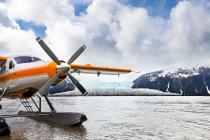Ketchikan: Green Gem of Alaska
The astounding landscape of Alaska is as massive as it is magnificent, and the tiny gem of Ketchikan is the diamond in the rough. This unassuming frontier town, nestled along the state’s southeast border, encapsulates centuries of Native American, Russian and U.S. history. Here, mountains rise directly from the craggy shoreline, dwarfing the colorful storefronts and fishing boats docked nearby. Ice and snow are a rare occurrence. Instead, rainfall in excess of 155 inches a year makes this destination—on the cusp of the world’s largest temperate rainforest—erupt with emerald green firs and cedars.
While the mere mention of Alaska evokes images of arctic waters and snow-laden tundra, there aren’t any igloos or polar bear to be found near Ketchikan. The one million cruise passengers who visit the state every year (who account for half its tourism) encounter instead a land of green forests, teeming rivers and fascinating cultural history. And once cruisers meet this Alaska, they come back. A third of the state’s visitors are repeat travelers returning to explore on their own.
For many, the tiny fishing village is gateway to Alaska’s 33,904 miles of coastline*. Accessible only by sea or air, Ketchikan holds the title of Alaska’s first city not because it was established before any other, but because it’s often the firststop when cruising north along the Inside Passage.
Creek Street and Beyond
When disembarking, many cruise passengers immediately head toward Creek Street, one of Ketchikan’s most memorable destinations. Creek Street is an antique boardwalk connecting shops, homes and restaurants that have been built on a base of underwater pilings along the shore. At the time of its construction in 1903, carving into Ketchikan’s rocky mountain backdrop would have been extremely difficult. The improvised solution? Build a town right over the water. The charming historic district is a visual feast. Fishing boats bob in nearby Thomas Basin Marina. The surrounding Tongass National Forest—the largest in the U.S.—provides a striking backdrop to the galleries, museums and cafes.
As passengers stroll, they may overhear shouts and cheers coming from the nearby Alaskan Lumberjack Show, where modern-day loggers chop, saw, climb, axe throw and balance on rolling tree trunks afloat in water. For a more laid-back experience, some take a vertical tram ride to Cape Fox Lodge to take in a land-sea-sky view they’ll never forget.
And as grandiose as Ketchikan’s vistas are, many discover the joy of simple pleasures, like peering mesmerized into the churning, tidal waters of Ketchikan Creek. The name Ketchikan comes from the Native Tlingit Tribe (pronounced Cling-et). Though the true meaning is lost, many believe the word means “thundering wings of an eagle”—perhaps a reference to the bald eagles often seen overhead, or to the roar of the creek itself.
Although it’s hard to think of a town with only three major streets as having a “downtown,” Ketchikan’s beloved Main Street would be it. This deviation from beloved Creek Street is where travelers discover KetchiCandies, a homegrown business that has quietly built an international following among cruisers with a sweet tooth. Rich with homemade fudge, peanut butter, high-end chocolate, decadent truffles and other delights, the friendly staff of Ketchicandies now ship their concoctions all over the world.
The warm, welcoming feel of Creek Street and Main Street make Ketchikan distinct. Since the area receives more rainfall than nearly anywhere else in North America, umbrellas are a common sight. But a few light, misty showers only add to Ketchikan’s charm. Most visitors are pleasantly surprised by the tee-shirt weather they experience in the Land of the Midnight Sun.
The Salmon Capital of the World
At a certain point during the summer months, when warm weather beckons tourists, Ketchikan’s rivers explode with salmon headed upstream to spawn. The turn-of-the-century Gold Rush brought miners to Alaska, but also led to a boom in commercial fishing and canning. Many prospectors never completed the treacherous journey north, choosing instead to settle in the much more temperate Ketchikan, where salmon were—and still are—its most precious natural resource.
However, the five species of salmon in the surrounding waters drew the first residents to this location centuries before this. Every summer, the Tlingit people descended upon the creek’s swift-moving waters to collect and cure salmon in preparation for the long winter months. Today, salmon fishing expeditions are some of Ketchikan’s most popular tourist excursions, allowing visitors to participate in a celebrated American tradition they can enjoy long after their vacation ends. The bounty of salmon they catch themselves are freeze-dried and shipped right to their homes.
The Totem Pole Capital of the World
Once visitors look up from the cobalt blue waters of Ketchikan, they’ll likely find themselves face-to-face with the 55-foot tall Chief Johnson totem pole, which stands sentinel at the mouth of the creek. This replica was erected 33 years ago after the original was damaged by eight decades of wet Alaskan winters. It lives just a few hundred yards from where the prototype did for nearly a century. This stunning column relays the mythological creation of salmon and the reason the fish visit Ketchikan Creek every summer. It is, perhaps, the most notable of the 100 totem poles in the area—the largest collection in the world.
Carved into the soft wood of Western Red Cedars with hand tools, many of these enormous columns date back to the 19th century. Although totem poles are associated with Native American culture at large, they truly belong to just a few tribes along the coast of Southeast Alaska and Canada border, telling the story of the first residents of Ketchikan and the surrounding region.
The Call of the Wild
Visitors to Ketchikan are as varied as Alaska itself. Many are nature enthusiasts. They look forward to a population of bald eagles that numbers in the tens of thousands—so common they’re visible throughout the seaports swooping down like seagulls for an afternoon snack. Some tourists are history buffs. These gold-rush romantics like to hear of adventure-ridden glory days when prospectors pushed west and north in search of freedom and fortune. Still others are adventurists who come to kayak in Pacific waters or hike through dense cedar forests.
For those who make it to America’s 49th state, the question inevitably becomes: ‘When can I go back?’ Sharon, a resident of southeastern Pennsylvania, first visited Alaska at the age of 50, and has been back twice since. She loved the wildlife like orange-beaked puffins and Harbor seals she observed up close on her cruise, and vividly recalls the Russian art evident in local church buildings. The fact that this unique landmass is one of the fifty United States makes exploring it, for her, a patriotic venture. She points out she’s not alone in her appreciation; “Everyone always says that seeing Alaska is a goal they have.”
When asked what advice she would give them, she replies, “They absolutely need to go. All the beauty you can see in pictures and on TV doesn’t even match what it’s like when you get there. The word I use is ‘vast’. You can’t even conceive of it. No place I’ve ever been to compares.”
‘Vast’ is right.The scope of Alaska’s terrain (larger than all but 16 sovereign nations) makes for a varied panorama that is virtually unrecognizable from one region to the next. And while the fishing village of Ketchikan isn’t bigger than a few narrow streets, it has earned its place on the map of Alaskan tourism.
Regardless oftheir reason for coming, almost all Christian travelerswho experience Alaska come home with a story about encountering God’s presence here. There’s something about being immersed in the awe-inspiring majesty of His Creation that amplifies His attributes and draws every soul closer to Him. If you journey to “America’s Last Frontier”—in Ketchikan and beyond—you too may find it a transformational experience, too.
*This figure is derived from the National Oceanic and Atmospheric Administration’s measurement method that includes tidal areas.






